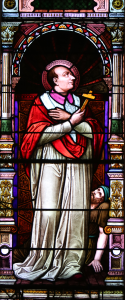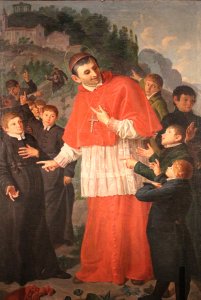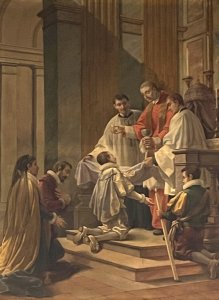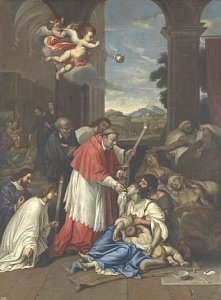Who Was St. Charles Borromeo?
Who Was St. Charles Borromeo?
St. Charles Borromeo: His Life, Times, and Legacy
By Reverend John P. Collins, Class of 1972
Early Years
Carlo (Charles) Borromeo came into the world on October 2, 1538 in the town of Arona, located near Lake Maggiore, in the Lombardy area of northwest Italy. He was the third of six children, two of whom were boys, born to Count Gilberto Borromeo and Margherita Medici. The family was bound by the law of primogeniture, meaning that only the oldest son, Federico, could inherit his father’s title, land, and fortune. Younger sons were traditionally sent into either the military or church service. Since his maternal uncle Giovanni Angelo Medici was an Archbishop, the latter option was chosen for Charles.

In 1545, he was tonsured, thus admitting him to the clerical state and was given an abbey near Arona, which would provide a yearly benefice (income) for him. As he matured, he would begin his religious studies at the University of Pavia, where on December 6, 1559, he would obtain a Doctorate Degree in Civil and Canon Law. Nineteen days later, on Christmas Day, his uncle Giovanni would be elected pope, taking the name Pius IV and succeeding Paul IV. On January 30, 1560, he would name Charles a cardinal and appoint him as Secretary of State and Administrator of the Archdiocese of Milan.

Turning Point
Tragedy struck the Borromeo family on the night of November 19/20, 1562. Charles’ older brother, Federico, who had succeeded his father as Count Borromeo died without leaving an heir. Charles, as the closest male relative, was eligible to succeed to the title and the family fortune. Since membership in the clerical state did not require the reception of sacred orders, as it does now, and the title of cardinal was one of honor, not requiring ordination, Charles could easily be laicized by his uncle, who indicated a willingness to do so, and be permitted to marry and carry on the Borromeo family name and title. After prayerful meditation, Charles chose to renounce the title, the money, and the marital state, choosing to remain a cleric. The events of history are not inevitable, although many find it difficult to imagine an alternative past. History is sometimes said “to turn on a dime.” Charles Borromeo is proof of that. His choice would alter both his own life and the path of the counter-reformation of the Catholic Church.
The Council of Trent
In 1542, Pope Paul III issued a call for an ecumenical council to counteract the teachings of Martin Luther and John Calvin. It was to be held in the town of Trent, located in the mountainous region of northeastern Italy. Its three purposes were to define Catholic doctrine, issue disciplinary regulations for the Church, and to restore Christian unity. It was successful in only the first two of these objectives. The council did not begin until three years later. During the first two sessions, 1545-49 and 1551-52, attendance was sparse and progress was slow. Finally in 1562, Pope Pius IV summoned a third session, appointing Cardinal Borromeo as one of its principal directors. It was this third session which proved to be the most productive. One important regulation of this session was Canon 18, which mandated a seminary in each diocese for the training of priests with special consideration for poor boys, thus not limiting the priesthood to the affluent. It prescribed classes in Latin grammar, chant, scripture, patrology, doctrine, liturgy, and accounting. In later years, the foundation of such seminaries would bring his most noteworthy fame to Charles Borromeo.

The Milan Years
Having previously chosen to remain in the clerical state, Charles Borromeo requested to receive sacred orders. He was ordained a priest on September 4, 1563 in the midst of the third session of Trent, and then raised to the order of bishop on December 7 of that same year, three days after the conclusion of the council. He was promoted from Administrator to Archbishop of Milan, the second largest diocese, after Rome in Italy. However, his position of Secretary of State required that he remain in Rome. Upon the death of Pius IV, the Dominican Antonio Ghislieri, with Borromeo’s support, was elected Pope in 1566, taking the name Pius V. Charles requested to be removed from his diplomatic post and be allowed to go to Milan. This was done, making Borromeo Milan’s first resident bishop in 80 years.
Borromeo implemented the Tridentine Reform in Milan. While still serving as administrator, he opened St. John the Baptist Seminary, with an enrollment of about 100 students. During his tenure as archbishop, five other seminaries were opened for about 700 students. He also educated the laity in his diocese by establishing the Confraternity of Christian Doctrine (CCD). In addition, Charles acted as a spiritual mentor to St. Aloysius Gonzaga, giving him First Holy Communion at age 12 in 1580.

He began a reform of religious orders by establishing the Oblates of St. Ambrose, a former Bishop of Milan, based on the Congregation of the Oratory of St. Philip Neri, a Milanese contemporary of Charles. The Oblates were later renamed in honor of Charles. Not all orders welcomed this reform. One in particular, the Humilitati, (ironic given Charles’ episcopal motto, Humilitas) had been formed in the 11th century as a reform order, but had grown wealthy and corrupt over the centuries as they processed wool and made clothing. When Charles appointed a new reformer superior general, one monk, Gerolamo Donato Farina, took matters into his own hand with an assassination plot. Musket shots were fired at Charles during Evening Prayer on October 26, 1569 in the Cathedral. Borromeo was wounded slightly and recovered. Pope Pius V would later suppress the Humilitati Order.
Two natural disasters occurred during his tenure as Archbishop. Namely, a famine in the 1560s and the plague in the 1570s. He responded by using his own money for relief by feeding the hungry and providing spiritual and material aid to the sick. He also aided the counter reformation in England by financial assistance to the English College at Douay, France, befriending the Jesuit priest Edmund Campion, who was later martyred.
Conclusion and Postscript
Charles Borromeo would pass away on November 3, 1584. He was 46 years of age. He would be canonized a Saint by Pope Paul V on November 1, 1610. As a result of his educational work during the reformation, he was named as the Patron Saint of both Catechists (CCD teachers) and seminarians. It is for this reason that in 1832, Bishop Francis Patrick Kenrick, when opening his new seminary in Philadelphia, chose the title “St. Charles Borromeo.”


